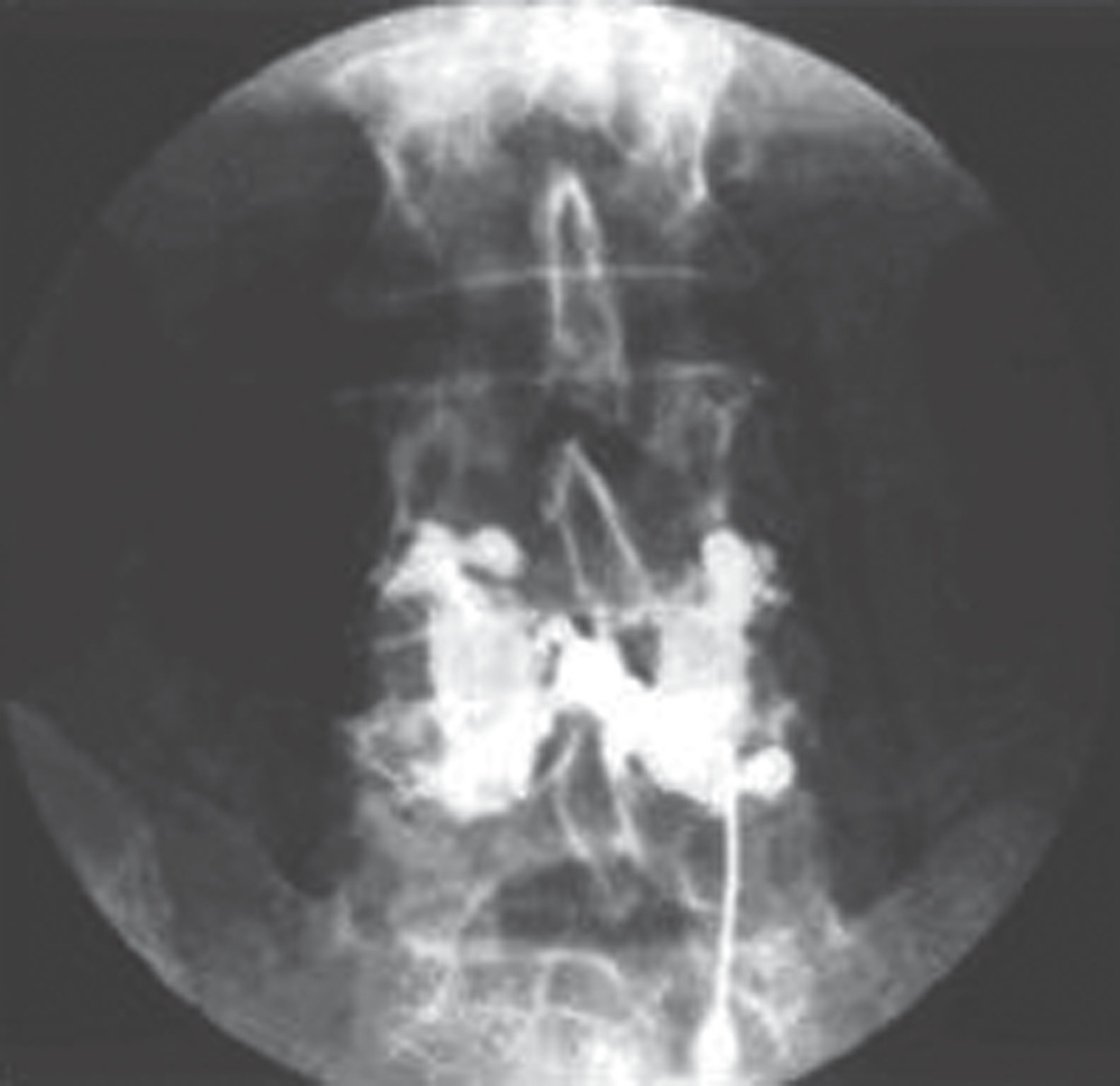Abstract
Study Design
Intra-articular injections of long acting steriod and local anesthetics after lumbar facet joint(LFJ) arthrography are routinely used for therapeutic purposes in selected patients for relief of chronic low back pain. However, because of the difficulty in finding an accurate position of the symptomatic joint, the possibility of complication and the placebo effect, there are doubts about the clinical application of this treatment.
Objectives
This study was designed to assess the diagnostic value and clinical benefits of lumbar facet joint arthrogram & injection of long acting steriod and local anesthetics in patients with facet joint syndrome.
Summary of Literature Review
The radiological relationship and the diagnostic elements of facet joint syndrome need to be analyzed and evaluated for increasing the effectiveness of lumbar injection.
Materials and Methods
Fifty two patients with low back pain were enrolled in the trial and they met the following criteria: pain for more than 3 months, no root signs and no history of back surgery. The response to facet joint injection was analyzed according to the chief complaints, a provocative test, the Visual Analogue Scale(VAS), the Helbig & Lee(HL) score, the facet block procedure and the arthrogram findings. A questionnaire with a pain scale was administered immediately or the day after injection, and then after 1, 3, 6 and 12 weeks. The arthrograms were reviewed by a radiologist & orthopedic specialist.
Results
One hundred sixty nine joint injections were performed in 52 patients (L 3-4, n=33; L4-5, n=64; L5-S1, n=72). Thirty one patients had a chief complain of back pain that was aggravated by extension/rotation of the trunk and the provocative test was positive in 73.1%. The rates of a good response in the study group were 69.2% after one day, 44.2% after 3 weeks and 36.5% after 12 months. Arthrograms revealed synovial cysts in 1 of these patients and 5 patients had abnormal communication with spondylolysis. Two patients had contrast extravasated into the epidural space during injection.
Conclusions
Lumbar arthrography showed a low diagnostic value. Lumbar injections, as a useful procedure to diagnosis facet joint syndrome, could be a useful palliative treatment modality for treating chronic lower back pain. But strict diagnostic criteria through a scoring system is needed to achieve a higher degree of predictability and effectiveness of facet joint injection
Go to : 
REFERENCES
1. Schwarzer AC, Aprill CN, Derby R, et al. The relative contributions of the disc and zygapophyseal joint in chronic low back pain. Spine (Phila Pa 1976). 1994; 19:801–6.

2. Ghormley RK. Low back pain with special reference to the articular facets with presentation of an operative procedure. JAMA. 1993; 101:1773–7.
4. Eisenstein SM, Parry CR. The lumbar facet arthrosis syndrome. Clinical presentation and articular surface changes. J Bone Joint Surg Br. 1987; 69:3–7.

6. Jeon CH, Lee WI, Kang SY. Intra and Extraspinal Infected Synovial Cyst of the Lumbar Spine. J Korean Soc Spine Surg. 1997; 4:357–64.
8. Byun YS, Kim HT. Iatrogenic Spinal Infection after Injection Therapy in Spine. J Korean Soc Spine Surg. 2006; 13:299–305.

9. Pedersen HE, Bluuck CFJ, Gardner E. The anatomy of lumbosacral posterior rami and meningeal branches of spinal nerve (Sinu-Vertebral nerve); with an experimental study of their functions. J Bone Joint Surg Am. 1956; 38:377–91.
10. Hirsch C, Ingelmark BE, Miller M. The anatomical basis for low back pain. Studies on the presence of sensory nerve endings in ligamentous, capsular and intervertebral disc structures in the human lumbar spine. Acta Orthop Scand. 1963; 33:1–17.

11. Kellgren JH. Observation on referred pain arising from muscle. Chin Sci Mol Med. 1938; 3:175–90.
12. Mooney V. The syndrome of low back disease. Orthop Clin of North Am. 1983; 14:505–15.
13. Rees WS. Multiple bilateral subcutaneous rhizelysis of segment nerves in the treatment of intervertebral disc syndromes. Ann Gen Pract. 1974; 26:126.
14. Shealy CN. Facet denervation in the management of back pain and sciatic pain. Clin Orthop Relat Res. 1976; 115:159–64.
15. Selby DK, Paris SV. Anatomy of facet hoints and its correlation with low back pain antemp. Orthop. 1981; 312:1097–103.
16. Lippitt AB. The facet joint and its role in spine pain: management with facet joint injection. Spine (Phila Pa 1976). 1984; 9:746–50.
17. Shih C, Lin GY, Yueh KC, Lin JJ. Lumbar zygoapophyseal joint injections in patients with chronic lower back pain. J Chin Med Assoc. 2005; 68:59–64.
19. Lee JC, Ahn MW, Ihn JC. Clinical evaluation of the intra-articular injection for lumbar facet joint syndrome. J Korea Orthop Assoc. 1989; 24:684–92.
Go to : 
Figures and Tables%
Table 1.
Number of injected facet joint for each spinal level.
| Spinal level | Case(injected facet joint/total facet joint) |
|---|---|
| L5-S1 | 72/104 |
| L4-5 | 64/104 |
| L3-4 | 55/104 |
Table 2.
Response to injection according to the major associated symptoms
| Symptom | Case (No. of Pt.) | Successful response% |
|---|---|---|
| Pain at extension/rotation | 51 | 54.4% |
| Back pain alone | 15 | 66% |
| Buttock & hip pain | 5 | 40% |
| Pain on SLRT | 1 | 100% |
Table 3.
Response to injection according to the findings of facet joint arthrography




 PDF
PDF ePub
ePub Citation
Citation Print
Print



 XML Download
XML Download